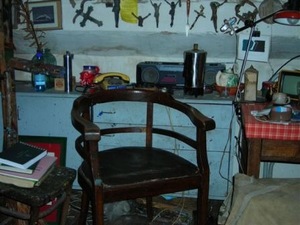IN MEMORIAM OF A.VAITKŪNAS. FROM LIFE IN WORKSHOP 0
Aušra Barzdukaitė-Vaitkūnienė
www.kamane.lt, 2008 04 02
The place of Arūnas’ thoughts in the workshop, M.Daukšos Str., Kaunas
“In winter at 3 a.m. at A.Martinaitis’ studio, I was waken up by crows which were clattering on the roof of the cathedral,” Arūnas wrote in his notebook in 1988.
Earlier the attic belonged to the painter A. Martinaitis (1939-1986).
“He used to sit here with R.P.Vaitiekūnas, E.Saladžius, A.Vilpišauskas,” said Arūnas.
After the death of A. Martinaitis in 1986, Arūnas inherited the workshop at the decision of the Artists’ Union. Arūnas had to repaint the wall which was turned into a telephone book by A. Martinaitis: “I could not work here otherwise. I felt like I was in a museum rather in a workshop. Still, I could not be in the empty workshop. White walls and nothing. A thing or an interior was necessary which would have some emotional information. Only later I felt that everything was rising from the inside.”
Things accumulated in the workshop little by little. They were found in attics of old Kaunas houses or during trips in Samogitia. The workshop filled with painted works or works in process of being painted.
Earlier Arūnas’ workshop was elsewhere. At the beginning, when he returned from the studies to Kaunas, he worked on the crossing of Vilnius Street and Laisvės Alley called the yard of gypsies.
From the stories of Arūnas: “The real Bohemia existed in this yard of gypsies. Gypsies used to come by white Volgas outside, while Justinas Mikutis read G.Traklis in my workshop.
Once the painter Jonas Maldžiūnas dropped by. We were speaking about art and drank a bottle of vodka while conversing. The conversation got hotter, and one more bottle was needed. It was nothing for Jonas, and I do not remember anything. It became clear in the morning that I chopped the door of gypsies by an axe. They were going to complain to their baron and prepare an execution for me. I got scared and apologised the gypsies. I worked all day till I repaired the door. An thus I conciliated with the neighbours.”
Arūnas had a workshop in Pergalės quay, which is Karaliaus Mindaugo Avenue at the moment. It was not large, and Arūnas spent nights there as there was not much place at home – the brother and his family lived there for a while.
He used to paint intensively, and the smell of paint and dissolvent lingered in the air. When he woke up in the morning, he had headache and felt the taste of turpentine and oil paint in the mouth.
When he moved to the attic in M.Daukšos Street, the number of such evenings and meetings decreased.
“Our company broke: Justis (Mikutis) died in 1988, Augis (Varkulevičius) left abroad, Stankutė (Algė) moved to Alsėdžiai, Maldžiūnas (Jonas) – to Kriūkai, Eglė (Velaniškytė) – to the countryside. Sometimes poetry evenings were organised here but another company gathered there already. Sometimes Angis members Alfa (Vilpišauskas), Eimis (Markūnas), Antanas (Obcarskas) dropped in, Jonas (Gasiūnas) came from Vilnius,” remembered Arūnas in 1996.
He was not inclined to organise parties or long meetings. If he did something, he did not stay long, he tried to go to the city or to friends.
The painter Antanas Obcarskas remembers: “Once we met the New Year untraditionally. It was 1986 most probably. I came to Arūnas two hours to twelve, and he was painting. We decided to visit E.Varkulevičius. Later the three of us got sad - we decided to visit Milda and Dainius Kairaičiai. Passing through the snow, we started searching for their house. We sat in the snow, talked and drank a glass of some drink, and later continued searching. We walked in Žaliakalnis in this way the whole night; however, we did not find the house.”
He used to leave the house in the morning and work till late night. If he did not paint, he contemplated. He felt good among paintings. He worked in the thoughts, thinking about the finished or started works.
Sometimes he used to repaint works finished long ago and paintings shown in exhibitions. This was how many good works disappeared under a new layer of paint; some works remained only in photographs.
Later, perhaps in 1999, Arūnas put this thought in his notebook: “If we admit that we may not decide to start doing something, we may put computers in order. There is no equality in the world of art as equality kills, levels, brings boredom and slumber.
Workshop is not a place of comfort, rest or prestige - it is a place of work”.

